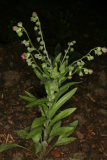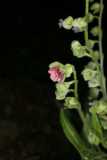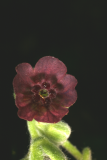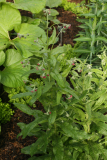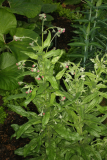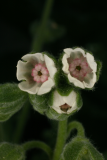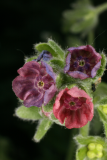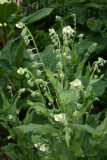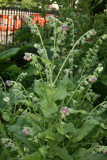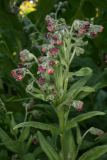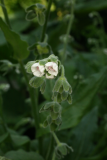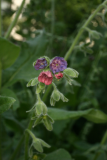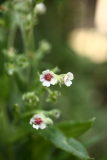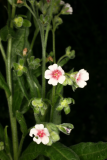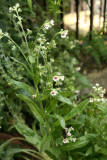Additional notes (click to expand)
Medicinal
Culpeper: “... being roasted and laid to the fundament, helps the haemorrhoids. It is also good against burnings and scaldings.”
Culpeper, Nicholas. (1650). A Physical Directory . London, Peter Cole.
Cynoglossum officinale L. Boraginaceae. Houndstongue. Distribution: Europe. Culpeper (1650) writes: “... being roasted and laid to the fundament, helps the haemorrhoids. It is also good against burnings and scaldings.” It contains hepatocarcinogenic pyrrolizidine alkaloids and while people are known to eat the young leaves as a vegetable, this is inadvisable. The whole plant is hairy and may cause contact dermatitis. The use of herbal remedies, which contain these alkaloids, by the Bantu of southern Africa correlates with their high incidence of tumours of the liver and pancreas.
Oakeley, Dr. Henry F. (2013). Wellcome Library notes.
link
Toxicity
It contains hepatocarcinogenic pyrrolizidine alkaloids and while people are known to eat the young leaves as a vegetable, this is inadvisable. The whole plant is hairy and may cause contact dermatitis. The use of herbal remedies, which contain these alkaloids, by the Bantu of southern Africa correlates with their high incidence of tumours of the liver and pancreas.
Vertebrate poison, mammals.
Germplasm Resources Information Network (GRIN) at www.ars-grin.gov/cgi-bin/npgs/html/tax_search.pl
Pyrrolizidine alkaloids poison liver, kidneys, lungs, heart. carcinogenic. Very dangeraous to non-ruminant animals.
Neuwinger, HD. (1996). African Ethnobotany: Poisons & Drugs, Chapman & Hall page 103
Contains hepatotoxic and carcinogenic pyrrolizidine alkaloids
Professor Anthony Dayan, 2022
Geographical distribution
- Asia-Temperate, Caucasus, North Caucasus
- Asia-Temperate, Caucasus, Transcaucasus
- Asia-Temperate, Middle Asia, Kazakhstan
- Asia-Temperate, Middle Asia, Kyrgyzstan
- Asia-Temperate, Russian Far East
- Asia-Temperate, Siberia
- Asia-Temperate, Western Asia, Iran
- Asia-Temperate, Western Asia, Turkey
- Europe, Eastern Europe, Baltic States
- Europe, Eastern Europe, Belarus
- Europe, Eastern Europe, Northwest European Russia
- Europe, Eastern Europe, South European Russia
- Europe, Eastern Europe, Ukraine
- Europe, Middle Europe, Austria
- Europe, Middle Europe, Belgium
- Europe, Middle Europe, Germany
- Europe, Middle Europe, Hungary
- Europe, Middle Europe, Netherlands
- Europe, Middle Europe, Poland
- Europe, Middle Europe, Slovakia
- Europe, Middle Europe, Switzerland
- Europe, Northern Europe, Finland
- Europe, Northern Europe, Great Britain
- Europe, Northern Europe, Ireland
- Europe, Northern Europe, Sweden
- Europe, Southeastern Europe, Albania
- Europe, Southeastern Europe, Bulgaria
- Europe, Southeastern Europe, Czech Republic
- Europe, Southeastern Europe, Greece
- Europe, Southeastern Europe, Italy
- Europe, Southeastern Europe, Romania
- Europe, Southeastern Europe, Yugoslavia
- Europe, Southwestern Europe, France
- Europe, Southwestern Europe, Spain
Cynoglossum officinale L.
Family: BORAGINACEAEGenus: Cynoglossum
Species: officinale L.
Common names: Hound's Tongue; Gypsyflower
Pharmacopoeia Londinensis name: Cynoglossum
Distribution summary: Eurasia
Habit: Biennial
Hardiness: H5 - Hardy; cold winter
Habitat: Dry grassland, scrub, meadows, open woodland, roadsides
Garden status: Currently grown
Garden location: Pharmacopoeia Londinensis 1618 'Roots' (HSE 2B), Pharmacopoeia Londinensis 1618 'Roots' (HSE 3)
Flowering months: June, July, August
Reason for growing: Medicinal, toxic
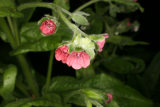
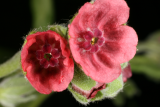

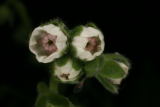
.JPG)
